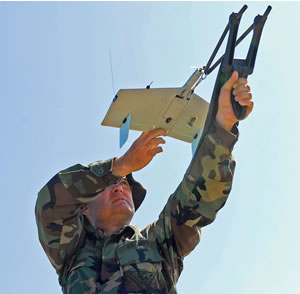
![]() After the Washington Post wrote about the Texas Department of Public Safety’s (DPS) and other domestic law enforcement agencies’ use of drones last January, EFF filed a Public Information Act request with the agency for more information. The Texas DPS was very forthcoming and not only sent us unredacted records of their program but also agreed to provide more information over the phone. The records they sent us are linked at the bottom of this post, and I was able to speak with Mr. Bill Nabors, chief pilot of Texas DPS’s Aircraft Section.
After the Washington Post wrote about the Texas Department of Public Safety’s (DPS) and other domestic law enforcement agencies’ use of drones last January, EFF filed a Public Information Act request with the agency for more information. The Texas DPS was very forthcoming and not only sent us unredacted records of their program but also agreed to provide more information over the phone. The records they sent us are linked at the bottom of this post, and I was able to speak with Mr. Bill Nabors, chief pilot of Texas DPS’s Aircraft Section.
Interestingly, according to Mr. Nabors, Texas hasn’t flown its drones since a final training flight in August 2010. The drones were constantly having maintenance issues because they weren’t designed to land in a rocky environment like Texas and didn’t fly well in high winds. The supplier, AeroVironment (AV), took a long time to fix the drones so they were often out of service. There also may have been some issues with the frequency used to operate and control the device. Ultimately, according to Mr. Nabors, the drones did not offer Texas significant advantages over the agency’s existing airplanes and helicopters so the agency cancelled its 2010 order for two additional drones. Mr. Nabors said he was not sure patrolling the border was a good use of the small drones or even whether they should be used in the National Airspace. He does believe the FAA should strictly control the use of unmanned aerial systems within the National Airspace. According to Mr. Nabors, he doesn’t see going back to using unmanned systems. Texas' experience should be taken seriously by other law enforcement looking into spending tax dollars to purchase these devices.
According to the records, DPS contracted in 2007 and 2008 with a partner of AeroVironment (AV), the largest supplier of small drones to the U.S. military, to purchase two of the company’s Wasp systems, a small UAS that is the result of a multi-year joint development effort between AV and DARPA, the Pentagon’s Defense Advanced Research Projects Agency. DPS wanted the drones to conduct “covert surveillance of ongoing criminal investigations, border security, accident reconstruction and standoff viewing of hazardous material scenes.” (p.2)  Each of these systems included two air vehicles and a ground control station. Two drone systems cost Texas $295,500.00. DPS submitted a second purchase order for additional drones in 2009, though it appears it cancelled the order in 2010.
Each of these systems included two air vehicles and a ground control station. Two drone systems cost Texas $295,500.00. DPS submitted a second purchase order for additional drones in 2009, though it appears it cancelled the order in 2010.
Wasps are small but powerful drones. Each weighs less than a pound and has a wingspan of 28.5 inches. For daytime operations, the Wasp uses “2048 x 1536 side imagers with digital pan-tilt-zoom (PTZ) capabilities.” The Wasp is also equipped with a “320 x 240 thermal imager” for nighttime operations. Another document notes that the Wasp includes “live video downlink, self tracking, still photography and nighttime IR technology.” According to AeroVironment’s Wasp Fact Sheet (pdf), the device can be operated manually but is also capable of GPS-based autonomous flight and navigation.
The documents we received also include the Texas DPS’s regulations for flying unmanned aircraft systems. These include operating procedures, FAA reporting requirements, requirements for flights using visual or instrument flight rules, and procedures to obtain an Emergency Certificate of Authority from the FAA.
Notably, the records DPS disclosed do not discuss any policies concerning which types of investigations DPS agents may use the drones for or whether they are required to obtain any legal process—such as a court order or warrant—before using the drones for surveillance. According to my phone conversation with Mr. Nabors, DPS does not feel it needs legal process to operate drones because they operate at 500 feet—the same height as a helicopter. However, Mr. Nabors also said that he thought the best use of drones was to aid SWAT teams to give agents the ability to see around things like buildings. It’s unclear whether a drone would need to fly at 500 feet to achieve this or whether that should even affect the legal analysis.
Despite Texas' experience, it doesn’t appear drones are going away. We’re still waiting to hear back from Public Records Act requests to other law enforcement agencies and will write more about those agencies’ programs and the FAA’s Certificate of Authorization program when we hear more.

![]() - Texas Department of Public Safety Unmanned Aircraft Regulations
- Texas Department of Public Safety Unmanned Aircraft Regulations
- Texas Department of Public Safety Wasp Purchase Documents
- Texas Department of Public Safety Wasp Maintenance Documents
- Texas Department of Public Safety Wasp Cancellation Documents
- AeroVironment Wasp Drone Info Sheet (external link to pdf)




